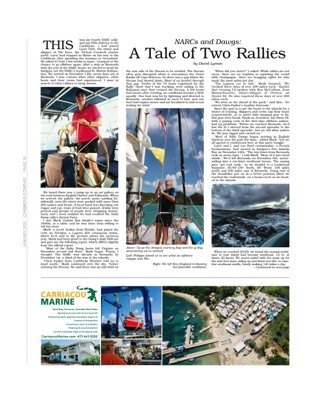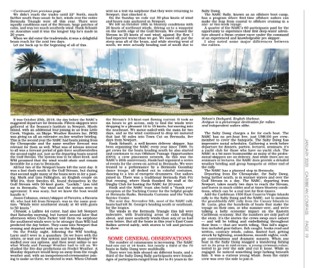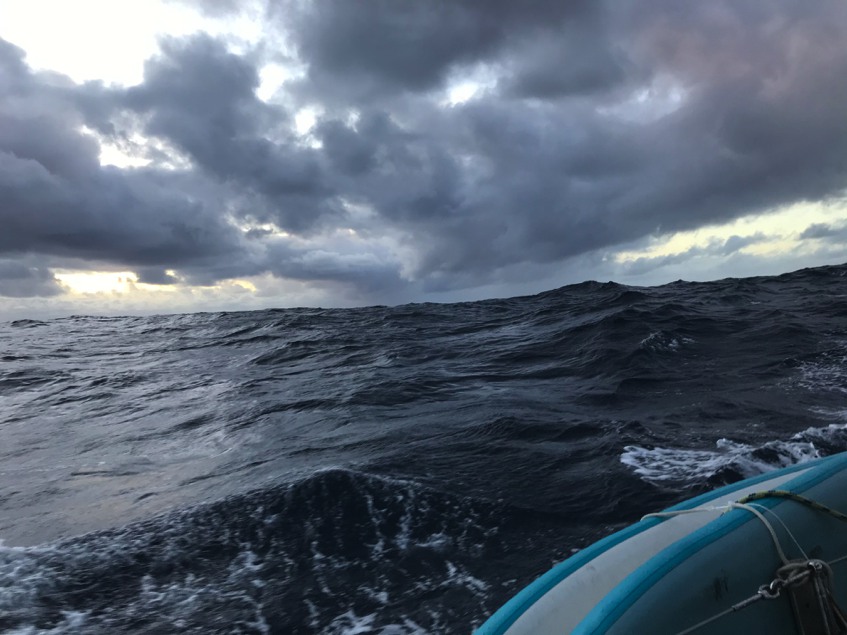The 2019 NARC and Salty Dawg Rallies to the Caribbean
Story and Photos by David Lyman
My report on the 2019 Rallies from the US East Coast to the Eastern Caribbean, published in the January 2020 edition of Caribbean Compass magazine.
THIS was my fourth NARC rally, and my 20th delivery to the Caribbean. I had joined Larry Tyler, the owner an skipper of The Dove, the 54-foot Crealock charter yacht. Larry had stopped in Maine on his way to the Caribbean after spending the summer in Greenland. He asked if I had a few weeks to spare. I jumped at the chance to go offshore again. After a stop in Bermuda with the rest of the NARC boats, we elected to head for Antigua, not the NARC’s traditional St. Martin destination. We arrived on November 12th, seven days out of Bermuda. I was curious what other skippers, other boats and their crews had experienced. I went in search of other ralliers to swap stories.
We heard there was a jump-up at an art gallery on the road between English Harbor and Falmouth. When we arrived, the gallery, the porch, patio, parking lot, sidewalk, even the street were packed with more than 200 sailors and locals. A local band was knocking out reggae and rap, trays of food were passed, drinks were poured and groups of people were swapping stories. Larry and I soon realized we had crashed the Salty Dawg rally’s Arrival Party.
I met Mark Outlaw (his family’s name since the 1600s), at a table, and he was more than willing to tell his story.
Mark, a yacht broker from Florida, had joined the crew on Paradox, a Lagoon 450 catamaran sedan, which he’d sold to the present owner the previous year. Mark had been glued to the Dawg’s daily SSB net and gave me the following report, which differs slightly from the official report.
“Most of the Salty Dawg boats left Virginia on November second and third,” Mark began. Funny, I thought. The NARC was already in Bermuda by November 1st, a third of the way to the islands.
“Chris Parker from Caribbean Weather told us to head south,” Mark continued over the din, “before entering the Stream. He said there was an odd swirl on the east side of the Stream to be avoided. The Stream often gets disrupted when it encounters the Outer Banks off Cape Hatteras. So there was a gap where the Stream had slowed down. “Most of us headed through that gap. Twelve of the 70 boats registered for the Rally, those that I was tracking, were sailing to the Bahamas once they crossed the Stream. A few boats had issues after crossing, as conditions became a little squally. One boat was hit by lightning and diverted to Bermuda, another followed in need of fuel, and one boat had engine issues and sat becalmed in mid-ocean waiting for wind.”
“When did you arrive?” I asked. While rallies are not races, there are no trophies or squirting the crowd with champagne, there are bragging rights for who made the most miles per day.
“ The Lagoon cat is fast,” Mark boasted. “We clocked three days of over 200 miles each.” Earlier that evening I’d spoken with Ken McCullum, from Massachusetts, owner/skipper of Orinoco, an Oyster 62. He also reported three days of over 200 miles each.
“We were so far ahead of the pack,” said Ken, “we outran Chris Parker’s weather forecasts.”
Since the goal is to get the boats to the islands for a winter of cruising, skippers and crews sail their boats conservatively, so to arrive with minimal gear to fix. But gear does break. Hank on Avocation, his Swan 48, with a paying crew of five first-time offshore sailors, had rig problems: “Before we reached Bermuda, we’d lost the D-1 shroud from the second spreader to the bottom of the third spreader, but we did what sailors do. We jury rigged and carried on.”
“Most of Salty Dawgs began arriving in English Harbour over the past few days,” added Mark, “but we all agreed to rendezvous here at this party tonight.”
Larry and I, and our third crew member, a French businessman, had arrived in Antigua’s Five Islands Bay on November 12th. “The trip down from Bermuda took us seven days,” I told Mark. “Most of it into head winds.” We’d left Bermuda on November 6th, motor- sailing into a ten-knot southeast breeze. The saying goes “get east early,” so we headed to a traditional waypoint: 30/60 (30° North, 60° West), 100 miles south and 200 miles east of Bermuda. Going east of the rhumbline put us in a better position when we reached the trade winds, on a beam reach as we head- ed to the islands.
When we reached 30/60, we found the normal northeast to east winds had become southeast, 12 to, at times, 20 knots, We motor-sailed with the main up for the next four days, riding up and down over five- to nine- foot southeast swells, barely making 140 miles a day.
We didn’t reach the trades until 22° North, much farther south than usual. In fact, winds over the entire Bermuda Triangle were off this year. There were squally conditions east of the Stream, large patches of calm, and way too much southerly wind. Hank Schmitt on Avocation said it was the longest trip he’s made in 20 years.
When we did enter the tradewinds, it was a delightful beam reach for the next two days.
Let me back up to the beginning of all of this.
It was October 25th, 2019, the day before the NARC’s suggested departure for Bermuda. Fifteen skippers were gathered at the Seamen’s Institute in Newport, Rhode Island, with an additional four joining in us from Little Creek, Virginia, on Skype. Weather Routers Inc. (WXI) was giving us all an extensive on-line weather briefing. This is the second year the NARC had boats joining from the Chesapeake and the same weather forecast was relevant for them as well. What was of intense interest to all was a forecast period of gale-force southwesterlies the second night out, just as the departing boats neared the Gulf Stream. The system was to be short-lived, and WXI promised that the wind would abate and remain favorable for the run to Bermuda.
All but two of the Newport boats left the next day. It was a fast dash south to the Gulf Stream, but during that second night many of the boats were in for a pasting. Mark and Lisa Pallington, an English couple on Wild Iris, their Sweden 45, found themselves in the Gulf Stream with 50-knot gusts. “Luckily,” Lisa told me in Bermuda, “the wind and the stream were in agreement. It was scary, but we knew the boat would handle it.”
Jason Calianos, owner/skipper of Parceira, a Bavaria 45, who had left from Newport, was in the same position. “Winds were southwest steady at 40 with gusts to 50 knots.”
Chinook, a Laffitte 44 cutter, had also left Newport that Saturday morning, but turned around later that afternoon when Chris Parker told them via satphone the southwest winds were to be stronger than WXI had predicted the day before. They came into Newport that evening and departed with us on the Monday.
On the Friday night, following the WXI briefing, Larry and I were in a quandary. Do we leave with the others, or wait out this system and leave Monday? We mulled over our options, and then went online to see what Windy and Passage Weather had to tell us. We studied the five-day predictions on PredictWind. A Monday departure would keep us away from the rough weather and, with an inexperienced crew member joining to make us three, we elected to wait. When Chinook sent us a text via satphone that they were returning to Newport, that clinched it.
On the Sunday we rode out 30-plus knots of wind and heavy rain anchored in Newport.
We left on October 18th in blustery conditions with 20 knots of northeast winds, driving us to a waypoint on the north edge of the Gulf Stream. We crossed the Stream in 25 knots of east wind, against the flow. I had expected worse than we got. We eased off, put the steep seas aft of the beam, and while steering west of south, we were actually heading east of south due to sent of the Gulkf Stream.
It took as six hours to get across, only to find the winds were dropping to a pleasant 12 to 15 knots, but moving into the southeast. We motor-sailed with the main for two days, and as the wind continued to drop we motored that last 50 miles into Town Cut on Bermuda, five days from Newport.
Hank Schmitt, a well-known delivery skipper, has been organizing the NARC every year since 1999. To get crews for the boats heading south he also started and continues to run Offshore Passage Opportunities (OPO), a crew placement network. As this was the NARC’s 20th anniversary, Hank had organized a series of events for the crews on arrival in Bermuda. We were treated to a performance by a Bermuda Goombay dance troupe, all decked out in colorful costumes, dancing to a trio of energetic drummers. Our sailors joined in. There was a traditional Bermuda Fish Fry that evening, where Hank thanked the staff at the Dinghy Club for hosting the NARC for 20 years.
Hank and the NARC team also held a “thank you” reception at the Yachting Center for the helpful people at Bermuda Radio, Bermuda Customs and the Yacht Service Center.
The next day, November 5th, most of the NARC rally boats had left St. George’s heading south or southeast, for the tropics.
The winds in the Bermuda Triangle this fall were indecisive, with frustrating areas of calm drifting about, and more southerly winds than any of us had seen before. But all the boats in this year’s East Coast Rallies arrived safely, with stories to tell and pictures to show.
SOME GENERAL OBSERVATIONS
The number of catamarans is increasing. The NARC had one out of 16 boats, but nearly a third of the 70 boats in Salty Dawg were multihulls.
There were ten kids aboard six different boats, and a third of the Salty Dawg Rally participants were female. Ages of participants ranged from five to 81 years in the
The Salty Dawg charges a fee for each boat. The NARC has no per-boat free, just US$100 per crew- member to cover the banquets. The Salty Dawg has impressive social schedules. Gathering a week before departure for dinners, parties, lectures, seminars, it’s a yacht club for those who have no yacht club. The NARC is a bit more businesslike as many of the profes- sional skippers are on delivery. And while there are no seminars or lectures, the NARC does provide a detailed weather briefing and group banquets at either end of the rally.
The NARC has a planned stop in Bermuda.
Departing from the Chesapeake, the Salty Dawg, being farther south, is in warmer waters and over the Gulf Stream in a day. The NARC, departing from Newport, takes a day and a half to reach the Stream, and leaves in much colder and at times blustery conditions, which can be a real test for first-timers.
Add the Caribbean 1500 East Coast to Virgin Islands rally to the Salty Dawg and the NARC, not to mention the granddaddy ARC rally from the Canary Islands to St. Lucia, plus the hundreds of boats that make the voyage on their own, or who summer-over, and we’re talking a hefty economic impact on the Eastern Caribbean economy. But the numbers are only part of the story. It’s the stories the crews swap once ashore — and will be telling and embellishing throughout their lives — that are worth telling. This fall’s migra- tion included gear failure, fish caught, books read and written, contrary winds, calms, limited fuel, getting struck by lightning, seasickness, moonlit nights, cock- pit conversations and dramatic sunsets. When one boat in the Salty Dawg snagged a wandering fishing net in its prop in mid-ocean, a young crewman volun- teered to go over the side and cut it loose. While so engaged, he noticed something large lurking beneath him. It was a curious young whale. Soon the entire crew was over the side to join it.


Above: Up go the Antigua courtesy flag and the Q flag, announcing we’ve arrived.
Left: Philippe joined us to see what an offshore voyage was like.
Right: We left New England in blustery but favorable conditions.
Nelson's Dockyard, English Harbour,
Antigua is a picturesque destination for rallies and independent sailors alike.

A few hours after land dropped below the horizon, the wind increased Northerely blowing 20-plus and the seas building to 10 feet, soon blowing away the clouds from a passing a front.